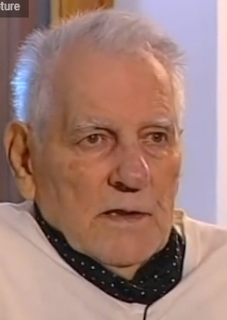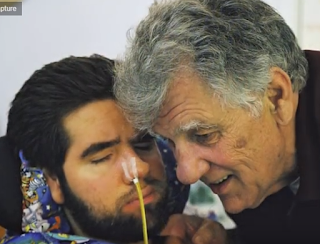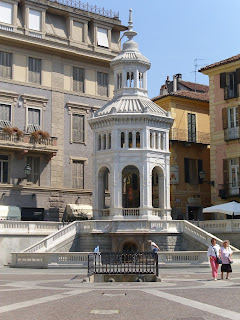Father who invented ‘Lorenzo’s Oil’ for sick son
 |
| Augusto Odone devoted his life to caring for his stricken son Lorenzo |
Augusto Odone, the father who invented a medicine to treat
his incurably ill son despite having no medical training, was born on this day
in 1933 in Rome.
Odone’s son, Lorenzo, was diagnosed with the rare metabolic
condition ALD (Adrenoleukodystrophy) at the age of six. Augusto and his
American-born wife, Michaela, were told that little could be done and that
Lorenzo would suffer from increasing paralysis and probably die within two
years.
Refusing simply to do nothing, the Odones, who lived in
Washington, where Augusto was an economist working for the World Bank, threw
themselves into discovering everything that was known about the condition and
the biochemistry of the nervous system, contacting every doctor, biologist and
researcher they could find who had researched the condition and assembled them
for a symposium.
Drawing on this pooled knowledge, and with the help of Hugo
Moser, a Swiss-born professor of neurology at Johns Hopkins University in
Baltimore, they eventually came up with the idea of combining extracts of olive
oil and rapeseed oil in a medicine that would break down the long-chain fatty
acids in the human body that were considered a major cause of the nerve damage
suffered by people with ALD.
The medicine, which seemed to slow the progression of
Lorenzo’s disease, soon became known as Lorenzo’s Oil. Against all odds,
Lorenzo survived until the day after his 30th birthday, having lived
more than 20 years beyond his doctors’ gloomy forecasts.
 |
| Lorenzo (left), with his father, lived for 22 years longer than doctors predicted after his diagnosis |
The Odones, moreover, were convinced that Lorenzo drew some
pleasure from being alive. He showed signs that he enjoyed music and listening
to stories and responded to voices, even though for the last 22 years of his
life he was paralysed, blind and unable to speak, could only be fed through a
tube and required round-the-clock nursing care. He communicated by blinking and
wiggling his fingers.
Their story attracted attention all over the world. It became the subject of a film, entitled
Lorenzo’s Oil, directed by George Miller and starring Nick Nolte and Susan Sarandon,
that was a box office hit and was nominated for two Academy Awards.
The movie attracted criticism from medical experts for
portraying scientists as unfeeling, although the Odones had been outspoken in
their comments about the response of the medical establishment to their
attempts to find a treatment.
Doctors also criticised the film for suggesting that Lorenzo’s Oil was a cure for ALD, although the medicine is still used today and has been
shown to delay the onset of symptoms if prescribed before they develop.
 |
| Lorenzo seemed a normal child until the age of four |
Augusto Odone, whose mother was a novelist and his father a
general in the Italian army, grew up in Gamalero, a village in Piedmont, not
far from Alessandria. He was educated at
the University of Rome before attending the University of Kansas on a
scholarship. He joined the World Bank in
1969.
He devoted much of his life to raising money for research
before deciding in 2010, two years after Lorenzo’s death, to move back to
Italy, settling in Acqui Terme, about 20km (12 miles) from Gamalero. He died there in 2013, aged 80, having
survived Michaela, his second wife, by 13 years.
His daughter by his first marriage is the Kenyan-born
English journalist and novelist, Christina Odone.
 |
| La Bollente in Acqui Terme |
Travel tip:
Acqui Terme in Piedmont, which is situated about 100km (62 miles)
southeast of Turin, is a town of just over 20,000 people best known for the
local wine, Brachetto d’Acqui, and for the hot sulphur springs that were
discovered during the Roman era, which bubble up at a temperature of 75 degrees
Celsius, emerging at a site in the centre of the town where a small pavilion,
called La Bollente, was built in 1870.
Travel tip:
Alessandria, a city of 94,000 people about equidistant from
Turin and Milan, is notable for the Cittadella, the 18th century star
fort across the Tanaro river from the city, which is one of the best preserved
fortifications of that era, with the outer wall and defensive towers still
intact. It is also home to a military
museum that contains more than 1500 uniforms, weapons and other memorabilia
from the Italian Army.
Find a hotel in Alessandria with Tripadvisor
More reading:
How Renato Dulbecco's research led to greater understanding of cancer
Find a hotel in Alessandria with Tripadvisor
More reading:
How Renato Dulbecco's research led to greater understanding of cancer
The first physiologist to explain human movement
Camillo Golgi - the greatest nueroscientist of the 19th century
Also on this day: